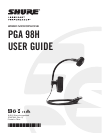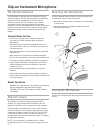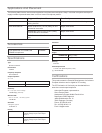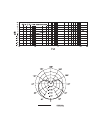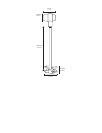
4
Applications And Placement
The following table lists the most common applications and placement techniques. Keep in mind that microphone technique is
largely a matter of personal taste; there is no one “correct” microphone position.
Application Suggested Microphone Placement Tone Quality
Reed Instruments Place microphone a few inches from and
aiming into bell.
Bright, minimizes feedback and leakage.
Brass & Woodwinds Brass: 30 to 90 cm (1 to 3 ft.) away, on-axis
with bell of instrument.
Bright, clear sound.
Woodwinds: 2.5 to 15 cm (1 to 6 in.) away,
on-axis with bell of instrument.
Bright, clear sound.
Bell of instrument 90° off-axis from front of
mic.
Softer, mellow sound.
Connector
PGA98H-XLR
Three-pin professional audio (XLR), male
PGA98H-TQG
TA4F
Weight
PGA98H-XLR
245 g (0.5 lbs)
PGA98H-TQG
75 g (0.2 lbs)
Housing
Cast Zinc
Power Requirements
11 to 52 V DC phantom power (2 mA)
[1] 1 Pa=94 dB SPL
Certifications
This product meets the Essential Requirements of all relevant
European directives and is eligible for CE marking.
The CE Declaration of Conformity can be obtained from:
www.shure.com/europe/compliance
Authorized European representative:
Shure Europe GmbH
Headquarters Europe, Middle East & Africa
Department: EMEA Approval
Jakob-Dieffenbacher-Str. 12
75031 Eppingen, Germany
Phone: 49-7262-92 49 0
Fax: 49-7262-92 49 11 4
Email: info@shure.de
Accessories
Foam windscreen for PGA98H and
PGA98D microphones
AP98WS
Specifications
Type
Electret Condenser
Polar Pattern
Cardioid
Frequency Response
60 to 20,000 Hz
Output Impedance
at 1 kHz
PGA98H-XLR
850Ω
PGA98H-TQG
600Ω
Sensitivity
at 1 kHz, open circuit voltage
-52 dBV/Pa[1] (2.51 mV)
Maximum SPL
1 kHz at 1% THD, 1 kΩ load, typical
130 dB SPL
Self Noise
A-weighted, typical
27 dB SPL-A
Polarity
PGA98H-XLR
Positive pressure on diaphragm produces
positive voltage on pin 2 with respect
to pin 3
PGA98H-TQG
Positive pressure on diaphragm produces
positive voltage on pin 3 with respect
to pin 1



